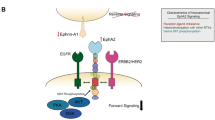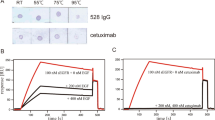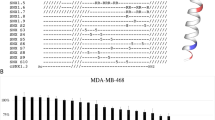Abstract
ErbB4 isoforms mediate different cellular activities depending on their susceptibility to proteolytic cleavage. The biological significance of ErbB4 cleavage in tumorigenesis, however, remains poorly understood. Here, we describe characterization of a monoclonal antibody (mAb 1479) that selectively recognizes the ectodomain of cleavable ErbB4 JM-a isoforms both in vitro and in vivo. mAb 1479 was used to analyse ErbB4 JM-a expression and ectodomain shedding in a series of 17 matched breast cancer/histologically normal peripheral breast tissue pairs. ErbB4 ectodomain was observed in 75% of tumors expressing ErbB4 but only in 18% of normal breast tissue samples expressing ErbB4. Difference in the relative quantity of ErbB4 ectodomain between normal and tumor tissue pairs was statistically significant (P=0.015). Treatment with mAb 1479 suppressed ErbB4 function by inhibiting ErbB4 tyrosine phosphorylation and ectodomain shedding, and by stimulating ErbB4 downregulation and ubiquitination. mAb 1479 suppressed both anchorage-dependent and -independent growth of human breast cancer cell lines that naturally express cleavable ErbB4 JM-a. These findings indicate that ErbB4 ectodomain shedding is enhanced in breast cancer tissue in vivo, and that mAb 1479 represents a potential drug candidate that suppresses breast cancer cell growth by selectively binding cleavable ErbB4 isoforms.
This is a preview of subscription content, access via your institution
Access options
Subscribe to this journal
Receive 50 print issues and online access
$259.00 per year
only $5.18 per issue
Buy this article
- Purchase on Springer Link
- Instant access to full article PDF
Prices may be subject to local taxes which are calculated during checkout






Similar content being viewed by others
References
Agus DB, Akita RW, Fox WD, Lewis GD, Higgins B, Pisacane PI et al. (2002). Targeting ligand-activated ErbB2 signaling inhibits breast and prostate tumor growth. Cancer Cell 2: 127–137.
Bao J, Wolpowitz D, Role LW, Talmage DA . (2003). Back signaling by the Nrg-1 intracellular domain. J Cell Biol 161: 1133–1141.
Borrell-Pages M, Rojo F, Albanell J, Baselga J, Arribas J . (2003). TACE is required for the activation of the EGFR by TGF-alpha in tumors. EMBO J 22: 1114–1124.
Carter P . (2001). Improving the efficacy of antibody-based cancer therapies. Nat Rev Cancer 1: 118–129.
Cheng QC, Tikhomirov O, Zhou W, Carpenter G . (2003). Ectodomain cleavage of ErbB-4: characterization of the cleavage site and m80 fragment. J Biol Chem 278: 38421–38427.
Cho HS, Mason K, Ramyar KX, Stanley AM, Gabelli SB, Denney Jr DW et al. (2003). Structure of the extracellular region of HER2 alone and in complex with the Herceptin Fab. Nature 421: 756–760.
Ding L, Getz G, Wheeler D, Mardis E, McLellan M, Cibulskis K et al. (2008). Somatic mutations affect key pathways in lung adenocarcinoma. Nature 455: 1069–1075.
Elenius K, Corfas G, Paul S, Choi CJ, Rio C, Plowman GD et al. (1997). A novel juxtamembrane domain isoform of HER4/ErbB4. Isoform-specific tissue distribution and differential processing in response to phorbol ester. J Biol Chem 272: 26761–26768.
Franklin MC, Carey KD, Vajdos FF, Leahy DJ, de Vos AM, Sliwkowski MX . (2004). Insights into ErbB signaling from the structure of the ErbB2-pertuzumab complex. Cancer Cell 5: 317–328.
Furger C, Fiddes RJ, Quinn DI, Bova RJ, Daly RJ, Sutherland RL . (1998). Granulosa cell tumors express erbB4 and are sensitive to the cytotoxic action of heregulin-beta2/PE40. Cancer Res 58: 1773–1778.
Gilbertson RJ, Bentley L, Hernan R, Junttila TT, Frank AJ, Haapasalo H et al. (2002). ERBB receptor signaling promotes ependymoma cell proliferation and represents a potential novel therapeutic target for this disease. Clin Cancer Res 8: 3054–3064.
Gilbertson RJ, Perry RH, Kelly PJ, Pearson AD, Lunec J . (1997). Prognostic significance of HER2 and HER4 coexpression in childhood medulloblastoma. Cancer Res 57: 3272–3280.
Gilmore JL, Riese II DJ . (2004). secErbB4-26/549 antagonizes ligand-induced ErbB4 tyrosine phosphorylation. Oncol Res 14: 589–602.
Gomes AQ, Ali BR, Ramalho JS, Godfrey RF, Barral DC, Hume AN et al. (2003). Membrane targeting of Rab GTPases is influenced by the prenylation motif. Mol Biol Cell 14: 1882–1899.
Haugen DR, Akslen LA, Varhaug JE, Lillehaug JR . (1996). Expression of c-erbB-3 and c-erbB-4 proteins in papillary thyroid carcinomas. Cancer Res 56: 1184–1188.
Hynes NE, Lane HA . (2005). ERBB receptors and cancer: the complexity of targeted inhibitors. Nat Rev Cancer 5: 341–354.
Iivanainen E, Paatero I, Heikkinen SM, Junttila TT, Cao R, Klint P et al. (2007). Intra- and extracellular signaling by endothelial neuregulin-1. Exp Cell Res 313: 2896–2909.
Junttila TT, Laato M, Vahlberg T, Soderstrom KO, Visakorpi T, Isola J et al. (2003). Identification of patients with transitional cell carcinoma of the bladder overexpressing ErbB2, ErbB3, or specific ErbB4 isoforms: real-time reverse transcription-PCR analysis in estimation of ErbB receptor status from cancer patients. Clin Cancer Res 9: 5346–5357.
Junttila TT, Sundvall M, Lundin M, Lundin J, Tanner M, Harkonen P et al. (2005). Cleavable ErbB4 isoform in estrogen receptor-regulated growth of breast cancer cells. Cancer Res 65: 1384–1393.
Junttila TT, Sundvall M, Maatta JA, Elenius K . (2000). Erbb4 and its isoforms: selective regulation of growth factor responses by naturally occurring receptor variants. Trends Cardiovasc Med 10: 304–310.
Kainulainen V, Sundvall M, Maatta JA, Santiestevan E, Klagsbrun M, Elenius K . (2000). A natural ErbB4 isoform that does not activate phosphoinositide 3-kinase mediates proliferation but not survival or chemotaxis. J Biol Chem 275: 8641–8649.
Katz M, Shtiegman K, Tal-Or P, Yakir L, Mosesson Y, Harari D et al. (2002). Ligand-independent degradation of epidermal growth factor receptor involves receptor ubiquitylation and Hgs, an adaptor whose ubiquitin-interacting motif targets ubiquitylation by Nedd4. Traffic 3: 740–751.
Klapper LN, Waterman H, Sela M, Yarden Y . (2000). Tumor-inhibitory antibodies to HER-2/ErbB-2 may act by recruiting c-Cbl and enhancing ubiquitination of HER-2. Cancer Res 60: 3384–3388.
Komuro A, Nagai M, Navin NE, Sudol M . (2003). WW domain-containing protein YAP associates with ErbB-4 and acts as a co-transcriptional activator for the carboxyl-terminal fragment of ErbB-4 that translocates to the nucleus. J Biol Chem 278: 33334–33341.
Lee HJ, Jung KM, Huang YZ, Bennett LB, Lee JS, Mei L et al. (2002). Presenilin-dependent gamma-secretase-like intramembrane cleavage of ErbB4. J Biol Chem 277: 6318–6323.
Määttä JA, Sundvall M, Junttila TT, Peri L, Laine VJ, Isola J et al. (2006). Proteolytic cleavage and phosphorylation of a tumor-associated ErbB4 isoform promote ligand-independent survival and cancer cell growth. Mol Biol Cell 17: 67–79.
Mendelsohn J, Baselga J . (2000). The EGF receptor family as targets for cancer therapy. Oncogene 19: 6550–6565.
Molina MA, Codony-Servat J, Albanell J, Rojo F, Arribas J, Baselga J . (2001). Trastuzumab (herceptin), a humanized anti-Her2 receptor monoclonal antibody, inhibits basal and activated Her2 ectodomain cleavage in breast cancer cells. Cancer Res 61: 4744–4749.
Ni CY, Murphy MP, Golde TE, Carpenter G . (2001). gamma-Secretase cleavage and nuclear localization of ErbB-4 receptor tyrosine kinase. Science 294: 2179–2181.
Omerovic J, Santangelo L, Puggioni E, Marrocco J, Dall'Armi C, Palumbo C et al. (2007). The E3 ligase Aip4/Itch ubiquitinates and targets ErbB-4 for degradation. FASEB J 21: 2849–2862.
Paatero I, Elenius K . (2008). ErbB4 and its isoforms: patentable drug targets? Recent Pat DNA Gene Seq 2: 27–33.
Paborsky LR, Fendly BM, Fisher KL, Lawn RM, Marks BJ, McCray G et al. (1990). Mammalian cell transient expression of tissue factor for the production of antigen. Protein Eng 3: 547–553.
Plowman GD, Culouscou JM, Whitney GS, Green JM, Carlton GW, Foy L et al. (1993). Ligand-specific activation of HER4/p180erbB4, a fourth member of the epidermal growth factor receptor family. Proc Natl Acad Sci USA 90: 1746–1750.
Prewett M, Rothman M, Waksal H, Feldman M, Bander NH, Hicklin DJ . (1998). Mouse-human chimeric anti-epidermal growth factor receptor antibody C225 inhibits the growth of human renal cell carcinoma xenografts in nude mice. Clin Cancer Res 4: 2957–2966.
Rio C, Buxbaum JD, Peschon JJ, Corfas G . (2000). Tumor necrosis factor-alpha-converting enzyme is required for cleavage of erbB4/HER4. J Biol Chem 275: 10379–10387.
Schlessinger J, Lemmon MA . (2006). Nuclear signaling by receptor tyrosine kinases: the first robin of spring. Cell 127: 45–48.
Slamon DJ, Clark GM, Wong SG, Levin WJ, Ullrich A, McGuire WL . (1987). Human breast cancer: correlation of relapse and survival with amplification of the HER-2/neu oncogene. Science 235: 177–182.
Srinivasan R, Benton E, McCormick F, Thomas H, Gullick WJ . (1999). Expression of the c-erbB-3/HER-3 and c-erbB-4/HER-4 growth factor receptors and their ligands, neuregulin-1 alpha, neuregulin-1 beta, and betacellulin, in normal endometrium and endometrial cancer. Clin Cancer Res 5: 2877–2883.
Srinivasan R, Poulsom R, Hurst HC, Gullick WJ . (1998). Expression of the c-erbB-4/HER4 protein and mRNA in normal human fetal and adult tissues and in a survey of nine solid tumour types. J Pathol 185: 236–245.
Sunada H, Magun BE, Mendelsohn J, MacLeod CL . (1986). Monoclonal antibody against epidermal growth factor receptor is internalized without stimulating receptor phosphorylation. Proc Natl Acad Sci USA 83: 3825–3829.
Sundvall M, Iljin K, Kilpinen S, Sara H, Kallioniemi O, Elenius K . (2008a). Role of ErbB4 in breast cancer. J Mammary Gland Biol Neoplasia 13: 259–268.
Sundvall M, Korhonen A, Paatero I, Gaudio E, Melino G, Croce C et al. (2008b). Isoform-specific monoubiquitination, endocytosis, and degradation of alternatively spliced ErbB4 isoforms. Proc Natl Acad Sci USA 105: 4162–4167.
Sundvall M, Peri L, Maatta JA, Tvorogov D, Paatero I, Savisalo M et al. (2007). Differential nuclear localization and kinase activity of alternative ErbB4 intracellular domains. Oncogene 26: 6905–6914.
Vecchi M, Baulida J, Carpenter G . (1996). Selective cleavage of the heregulin receptor ErbB-4 by protein kinase C activation. J Biol Chem 271: 18989–18995.
Witton CJ, Reeves JR, Going JJ, Cooke TG, Bartlett JM . (2003). Expression of the HER1-4 family of receptor tyrosine kinases in breast cancer. J Pathol 200: 290–297.
Zhang K, Sun J, Liu N, Wen D, Chang D, Thomason A et al. (1996). Transformation of NIH 3T3 cells by HER3 or HER4 receptors requires the presence of HER1 or HER2. J Biol Chem 271: 3884–3890.
Acknowledgements
We thank Tero Vahlberg and Tuire Palokangas for statistical analyses, and Maria Tuominen, Minna Santanen and Mika Savisalo for excellent technical assistance. This work has been supported by Academy of Finland, Finnish Cancer Organizations, Finnish Cultural Foundation, Foundation for the Finnish Cancer Institute, Jenny and Antti Wihuri Foundation, Sigrid Jusélius Foundation, Turku University Central Hospital and Research and Science Foundation of Farmos.
Author information
Authors and Affiliations
Corresponding author
Additional information
Supplementary Information accompanies the paper on the Oncogene website (http://www.nature.com/onc)
Supplementary information
Rights and permissions
About this article
Cite this article
Hollmén, M., Määttä, J., Bald, L. et al. Suppression of breast cancer cell growth by a monoclonal antibody targeting cleavable ErbB4 isoforms. Oncogene 28, 1309–1319 (2009). https://doi.org/10.1038/onc.2008.481
Received:
Revised:
Accepted:
Published:
Issue Date:
DOI: https://doi.org/10.1038/onc.2008.481
Keywords
This article is cited by
-
The role of ErbB4 in cancer
Cellular Oncology (2020)
-
Gamma-secretase-dependent signaling of receptor tyrosine kinases
Oncogene (2019)
-
HER4 expression in estrogen receptor-positive breast cancer is associated with decreased sensitivity to tamoxifen treatment and reduced overall survival of postmenopausal women
Breast Cancer Research (2018)
-
Association between ERBB4 gene polymorphism in the microRNA binding site and endometrial carcinoma risk
Genes & Genomics (2015)
-
Overexpression of ERBB4 JM-a CYT-1 and CYT-2 isoforms in transgenic mice reveals isoform-specific roles in mammary gland development and carcinogenesis
Breast Cancer Research (2014)



